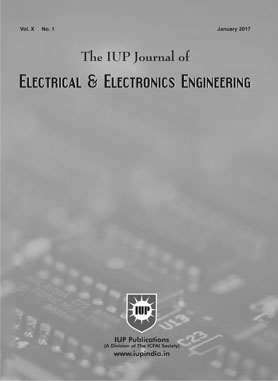
Oct'23
The IUP Journal of Electrical and Electronics Engineering
Focus
Multiport DC-DC (MDC) converters are preferred in PV systems with multiple renewable energy sources or storage units due to their compactness, fewer components and reduced complexity. In the second paper, "Performance Analysis of Multiport Converters in Standalone PV Applications", by S Sharma and K Rajambal, various topology configurations of MDCs like partially-isolated, isolated and non-isolated have been studied. The influence of converter duty ratio and varying solar intensities on the performance is examined.
Power electronic devices cause power quality problems in the grid like harmonic distortion, voltage sag and swell, current and voltage disruptions, etc. In the last paper, "Simulation of a 250 kW PV Connected Power System Using Fuzzy Logic", by Mohd Mustafa, A Ragavendiran and G Anandha Kumar, harmonic analysis of a PV system connected to grid is studied using Simulink model of a 250 kW PV system. Harmonic filters are designed and performance is analyzed using harmonic spectrum.
Editor-in-Chief
Efficiency Improvement at Signalized Intersections: Investigating Smart Green Time Allocation with Two LiDAR Sensors and AIMSUN Microsimulation
This paper addresses the critical issue of intersection efficiency through the implementation of Smart Green Time Allocation (SGTA) strategies at a signalized intersection equipped with two LiDAR sensors. It investigates optimal GTA provided by two LiDAR sensors and analyzes the LiDAR results by microsimulation in AIMSUN. Through meticulous modeling and simulation, the research explores the optimal green allocation at morning, mid-day and afternoon peak hour scenarios to comprehensively assess the impact of LiDAR-enabled dynamic signal control. The findings demonstrate that smart GTA, informed by real-time LiDAR data and implemented through AIMSUN microsimulation, significantly enhances intersection efficiency. By adapting signal timings to real-time traffic demands, congestion, travel time and emission are reduced. The paper highlights that optimal GTA in morning, mid-day and afternoon peak hour intervals can improve the delay time by 55.3%, 59.7% and 55.6%, respectively. In conclusion, the paper sheds light on the potential of LiDAR technology to transform intersection management.
Performance Analysis of Multiport Converters in Standalone PV Applications
The paper presents a unique approach to addressing the conversion of power requirements for standalone photovoltaic (PV) systems through the development of a multiport multi-bus power converter with partial power processing (PPP) capability. The primary objective is to improve the overall performance and efficiency of the PV system by effectively integrating multiple energy sources and loads. Maximum PPP method is applied by connecting one of the primary converter ports in series between the input and output. The aim is to optimize the converter's performance and achieve maximum power conversion efficiency. The performance of the converter is studied for various solar intensities. The effects of duty ratio of the converter are examined, and the optimum modulation index to maintain AC output constant for different intensities is identified. The results are discussed in detail.
Simulation of a 250 kW PV Connected Power System Using Fuzzy Logic
Many recent studies have revealed that power quality concerns in existing energy systems must be eliminated in order to meet today's energy sector needs. With rising living standards comes rising per capita energy demand, which may be met by expanding the use of renewable resources. Many researchers have identified strategies to incorporate renewable energies into the current energy sector across the globe. Adding renewable energy sources has created additional power quality challenges such as harmonic distortion, voltage sag and swell, current and voltage disruptions, etc., which influence system dependability. Power quality concerns must be solved in order to fully incorporate renewable energy sources. In this paper, a 250 kW PV system has been modeled and connected to the current grid infrastructure. Harmonic analysis was also performed with the PV system's connected grid, and harmonic filters were created to be connected in parallel with the PV system and the current system. The simulation is carried out in MATLAB Simulink.
| Click here to upload your Articles |
Journals
Magazines
- HRM Review
- Marketing Mastermind
- Global CEO
- The IUPs World of IOT
Articles of the Month


 ISBN: 978-81-314-2793-4
ISBN: 978-81-314-2793-4Price: ₹250
Payment by D.D. favouring
"ICFAI A/c IUP", Hyderabad
Reach us at
info@iupindia.in
Tel: +91 8498843633